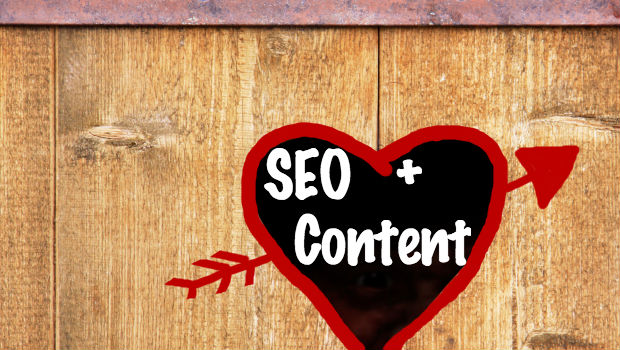
6 Ways to Keep SEO and Content Sittin’ in a Tree, K-I-S-S-I-N-G
Think back to high school and your first puppy love experience. If you were a rebel, you might have written your name and your new love interest on the bathroom wall with a big heart surrounding the two names. Well, in the bathroom stall of Small Biz High School, you will surely find SEO <3’s Content. SEO has always had the hots for content, but never had the courage to make it known to the world. After a slew of Google updates that attacked poor, low quality content, SEO and content are now the cutest couple on the block.
Here are 6 great ways to keep your SEO and content k-i-s-s-i-n-g in the tree:
Quality Over Quantity
The landscape of SEO has drastically changed in the past few years, and the days of building thousands or millions of links are long gone. The same goes for your relationship between SEO and content. Having low quality blog posts or articles will not only hurt your website in Google’s and Bing’s eyes, but your readers will notice the lack of substantial content. If your readers don’t find value in your content, they won’t return, and more than likely won’t share your posts on their social networks.
Diversity
“Diversity” is the SEO buzzword of 2013. Keep your anchor text, landing page and links diverse. We know you may have the urge to only link to your top selling item on your home page, but resist this temptation. We now know that Google doesn’t like that and won’t rank your site as high if you have an artificial or over-optimized link profile. A link profile consists of the links from other sites that are pointing to your site. Search engines want to see a natural link profile. Here is a great way to double check and make sure you are linking naturally in your posts: If you mention a cool new marketing resources blog, like Skadeedle, you would expect to be linked directly to that site. That’s how you want to link to your own site in your blog posts. This is also known as internal linking. If your internal linking is smooth and easy to read, and the content is valuable, readers should enjoy it and share your content.
No Minimums
Setting up minimums for word count and/or keyword requirements on your blog or blog posts leads to unnatural looking posts and not to mention hard-to-understand posts. If you own an online coffee mug store called Chipper’s Coffee Mugs, and every 5th word on your site is “Chipper’s Coffee Mugs,” it’s difficult to actually gather any substantial information. If your post is too short, readers might suspect that it lacks any value. A post that is too long runs the risk of losing the reader’s attention. Over time, you’ll find that word count sweet spot that your readers enjoy.
Google Authorship
You have great content that’s relevant and high quality, and you want to rank high in Google. How do you get the two together? Google Authorship is the answer. Authorship has been buzzing in the SEO community for the past year or so. With cool SEO plug-ins (available on self-hosted blogs) like Yoast, setting up your Google Authorship is easy. We could spend a whole post just explaining why Authorship is so important, but Mike Arnesen from SwellPath did a top-notch job, so check out why author rich snippets are important.
Small Stuff You Need to Sweat and Not Forget
Once you finish that masterpiece of a blog post, don’t set it and forget it! Make sure to remember these small details that’ll help your content get all the juicy SEO love it can:
Meta Data
This is getting into some semi-technical SEO stuff, but don’t get scared and stop because that Yoast plug-in makes it so very easy for you. Meta data is what’s displayed when your site is served in the SERP. A SERP is the search engine results page, or in layman’s terms, the Google or Bing results page. The meta title is the title of the page and it should be a maximum of 70 characters. The meta description is a preview of the post that’s also served up in the SERP. Be sure to limit your meta description to 160 characters for optimal results.
Images count too!
Don’t just paste your images into your blog post without first adding some nice SEO value to it. Images need some love too! Make sure to include the keyword in the file name of the image. So change “photo1472368.jpg” to “chipscoffeemuglogo.jpg” to make your images complement your amazing content. Remember the Google Bot doesn’t have eyeballs, so you have to tell it what your images are. That is where alt text comes in. You want to make sure to include some descriptive alt text on your images so the Google Bot knows what your image is about. Before you go crazy on your images, don’t keyword stuff your alt tags or file names. Your photo called “coffeemugsmugscoffee_coffee_mugsmugsmugs.jpg” will surely get the Google Bot’s attention and not in a good way.
If you’ve been thinking of starting, ramping up or enhancing your content game, these six tips will not only help your content get all the SEO love it can, but will help you avoid being negatively impacted by any Google updates like the Google Skunk. Remember, good SEO takes time and implementing these changes won’t get your to page to the first page over night. Like Billy Joel said, “keep the faith” and these SEO tips will help in the long run.
Do you have a success story from using Google Authorship or any of these other tips? We’d love to hear about it!
© 2013 – 2018, Contributing Author. All rights reserved.





I started implementing Google authorship, realizing its importance only after reading this post.I had heard about it before but never knew Google will catch up on it so fast. Better late than never I guess. Thanks.
I have been pushing my business partners on the importance of Google+ authorship over the past 6-12 months. I was happy to find this articled discussed the topic. I will be sure to share this article with my business partners and clients to make sure they realize the importance.
Whoomp whoomp! Thanks for reading and the kind words.
Thank you so much for your statement about word minimums! I cannot stand inflated posts that are obviously that way just to meet a word count. I’d so much rather read a concise (although short) post that gets right to the point without me having to dig through a bunch of fluff words.
Lisa,
Thanks for reading and I’m glad you liked it!
Chipper
Thanks for reading Jason! It sounds like you are taking all the right steps to rocking it with all your sites. Keep up the good work!
Nancy,
Glad you got the joke:) You want to make sure your content provides value to the user. Sometimes that is a few sentences, a few paragraphs or even an image.
Chipper
Great point Chris! You need a good (content) king, unlike Joffrey from Game of Thrones.
Thanks for reading Eilidh! Glad you like the post.
Thank Ryan! We love easy to use, kick ass tools like Boostsuite to keep on top of our SEO goodness. Google Authorship is the next big thing! 🙂
Chipper
Jeff,
What a great question! Like I said in the “minimums” section of the post, there is no real golden rule for links. I personally just try to make the post as informational and natural as possible. If you didn’t know who Matt Cutts is, which you really should 😉 you could just follow the link to his Twitter account and see what he is all about. Thanks for reading and the question!
Chipper
Thanks for the awesome post! I have a Q. I noticed you included several links in your post, is there a certain rule of thumb to be aware of when creating links in a post? I have heard a few times 2 links to a site, 1 link to an authority, 1 inner link per 500-800 words. How accurate is that?
Great tips as usual Chipper!
We make it a point to focus on the meta data within each of our posts. It’s such a useful and easy tool that it’s a shame seeing some businesses completely neglect it or just duplicate it on every page, no matter what the content says.
I’ll definitely have to check out this Google Authorship. Sounds like a cool opportunity.
Cheers!
Very interesting way of looking at SEO and content! Some great ideas here. Thanks!
Agree, agree, agree. 🙂 Content is definitely king, but it has to be done the right way. The other day I listed to an “SEO expert” tell a small business owner to create as much content as possible. What he left out is it needs to be good. I’ve been in the business long enough not to tell someone to do a lot of something… they’ll end up drowning in weak content.
Did anybody else sing the song like an 8 year old when they read the title? “K-I-S-S-I-N-G”. Takes me back. Anyway, I appreciate the no minimums on content generation but what about a standard of sheer volume. Isn’t it possible to be overlooked or possibly penalized for having a lesser amount of text content on a page. Even if it’s to the point. A few sentences could be overshadowed by pages with far more text content on the same subject. Point being always look to expand enough where any questions are answered that may be asked.
Laurie,
Thanks for the kind words! Blog posts can totally be under 500 words, short and sweet is the way to go sometimes.
I just wanted to comment and let you know I curated this content over at http://www.internetbillboards.com. I was immediately drawn to your headline, and the images. All six of your tips are what people need to see! I feel some blog posts could be under 500 words, but because of word and link stuffing to get a higher ranking…we are seeing some bloated posts that I will not read! Great job!
Nice article Chipper. I only started getting serious about blogging in the past 6 months. Aside from blogging, I also like to create what many refer to as niche or micro niche sites. The thing with these type of sites, and why they get such a bad name is most people create them merely for profit, they add no real value or personality, and they are a dime a dozen. The sites I create are all linked to my Google Plus profile. I always use authorship (wheras many niche sites don’t) and love connecting with others. It’s amazing how just a few changes regarding SEO can really have on a blog. I’m definitely not an SEO expert but I employ the suggestions you outline here on this post and I seem to do pretty well. In fact, all of the “niche” sites as well as blogs I have created that are over 3 months old are already ranking on page 1 in Google, some in top 3 spots. I like what you said about quality over quanity in regards to links. I still see a lot of bloggers out there thinking they’re going to rank because they get a ton of (crap) links. I don’t have very many links to any of my sites, but they are mostly high quality and natural links which is the goal!
Gained some great ideas and knowledge in terms of SEO and content. Thank You for sharing this valuable post with us.